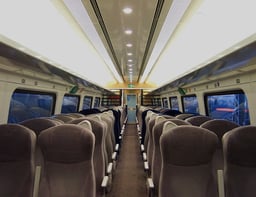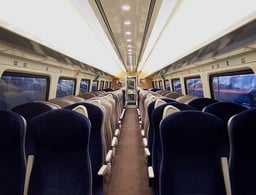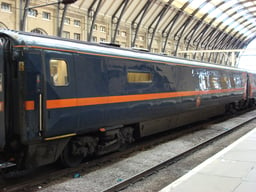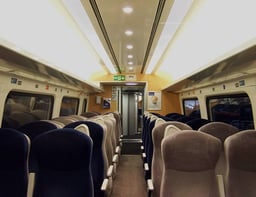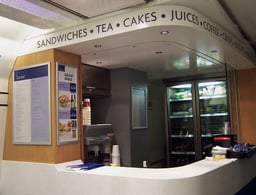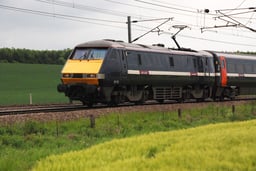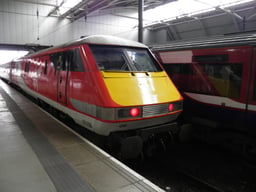InterCity 225
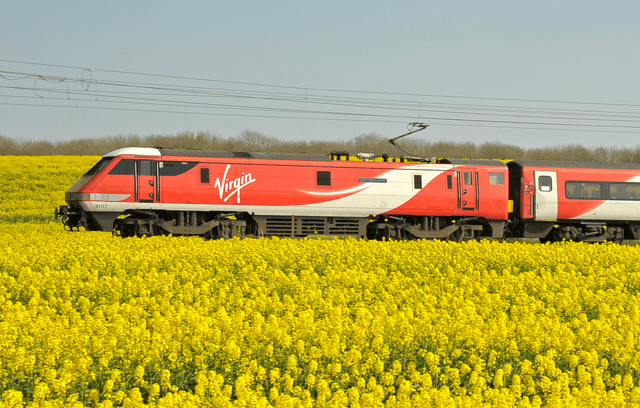
InterCity 225

| InterCity 225 | |||||||||||
|---|---|---|---|---|---|---|---|---|---|---|---|
| |||||||||||
| |||||||||||
| |||||||||||
| |||||||||||
| Type and origin | |||||||||||
| Power type | Electric | ||||||||||
| Builder | BREL, GEC-Alsthom, Metro Cammell | ||||||||||
| Build date | 1988—1991 [1] | ||||||||||
| Total produced | 31 nine-carriage units [2] | ||||||||||
| Specifications | |||||||||||
| Configuration: | | ||||||||||
| • UIC | Bo′Bo′+2′2′+...+2′2′+2′2′ | ||||||||||
| Performance figures | |||||||||||
| Maximum speed | 140 mph (225 km/h) (Design) 125 mph (201 km/h) (Service) 161.7 mph (260.2 km/h) (Record) | ||||||||||
| Power output | 6,300 horsepower (4.7 MW) | ||||||||||
| Career | |||||||||||
| Operators | Past British Rail GNER National Express East Coast East Coast Virgin Trains East Coast Current London North Eastern Railway | ||||||||||
| Disposition | In service | ||||||||||
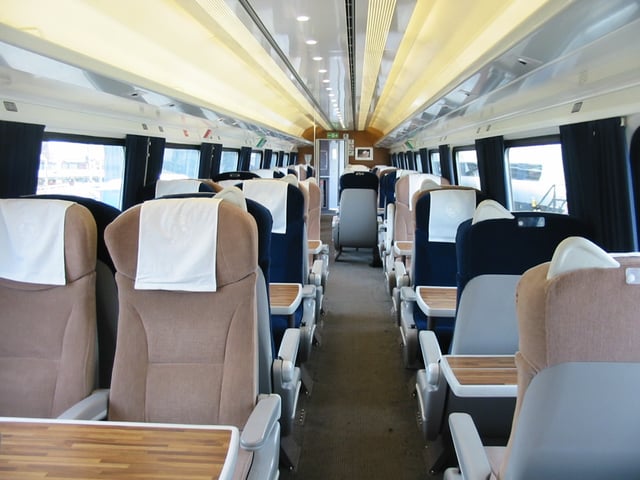
Project Mallard refurbished First Class carriage
The InterCity 225 is an electric high speed train in the United Kingdom, comprising a Class 91 electric locomotive, nine Mark 4 coaches and a Driving Van Trailer (DVT). The Class 91 locomotives were built by British Rail Engineering Limited's Crewe Works as a spin-off from the Advanced Passenger Train project,[3][4] which was abandoned during the 1980s, whilst the coaches and DVT were constructed by Metro Cammell in Birmingham and Breda (under sub-contract) in Italy, again borrowing heavily from the Advanced Passenger Train. The trains were designed to operate at up to 140 mph (225 km/h) in regular service, but are limited to 125 mph (200 km/h) principally due to a lack of cab signalling and the limitations of the current overhead line equipment. They are used on services from London King's Cross to Newark North Gate, Doncaster, Leeds, Bradford Forster Square, Skipton, York, Newcastle, Edinburgh Waverley and Glasgow Central.
| InterCity 225 | |||||||||||
|---|---|---|---|---|---|---|---|---|---|---|---|
| |||||||||||
| |||||||||||
| |||||||||||
| |||||||||||
| Type and origin | |||||||||||
| Power type | Electric | ||||||||||
| Builder | BREL, GEC-Alsthom, Metro Cammell | ||||||||||
| Build date | 1988—1991 [1] | ||||||||||
| Total produced | 31 nine-carriage units [2] | ||||||||||
| Specifications | |||||||||||
| Configuration: | | ||||||||||
| • UIC | Bo′Bo′+2′2′+...+2′2′+2′2′ | ||||||||||
| Performance figures | |||||||||||
| Maximum speed | 140 mph (225 km/h) (Design) 125 mph (201 km/h) (Service) 161.7 mph (260.2 km/h) (Record) | ||||||||||
| Power output | 6,300 horsepower (4.7 MW) | ||||||||||
| Career | |||||||||||
| Operators | Past British Rail GNER National Express East Coast East Coast Virgin Trains East Coast Current London North Eastern Railway | ||||||||||
| Disposition | In service | ||||||||||
Service history
The InterCity 225 entered service with InterCity on the East Coast Main Line (ECML) in 1989.[5]
They have also operated on the West Coast Main Line (WCML). In April 1992, one set a record of two hours, eight minutes between Manchester and London Euston, shaving 11 minutes off the 1966 record.[6] In 1993 trials were operated to Liverpool and Manchester in connection with the InterCity 250 project.[7]
In 1996, as part of the privatisation of British Rail, all InterCity 225s were sold to Eversholt Rail Group, which currently leases them to London North Eastern Railway (LNER).
The InterCity 225 has a top service speed of 140 mph (225 km/h); during a test run in 1989 on Stoke Bank between Peterborough and Grantham an InterCity 225 reached 162 mph (260.7 km/h).[5] However, except on High Speed 1, which is equipped with cab signalling, British signalling does not allow trains to exceed 125 mph (201 km/h) in regular service, due to the impracticality of correctly observing lineside signals at high speed.
Between 2001 and April 2006, HSBC Rail funded with support from GNER, Bombardier Transportation, Alstom and others a complete rebuilding and refurbishment programme for both the Class 91 and Mark 4 coaches, called Project Mallard.
With the entry into service of the first Class 800s, withdrawals commenced in May 2019 with the first stored at Harry Needle Railroad Company's Worksop yard.[8]
Capacity and Formation
The formation of the InterCity 225 sets is below:- [9]
Class 91 Electric Locomotive (North End)
Coach B - Standard Class - 76 Seats - WC
Coach C - Standard Class - 76 Seats - WC
Coach D - Standard Class - 76 Seats - WC
Coach E - Standard Class - 76 Seats - WC
Coach F - Standard Class - 72 Seats - Accessible Toilet
Coach H - Standard Class/Kitchen - 30 Seats - WC
Coach K - First Class - 43 Seats - WC + 2 Crew Areas
Coach L - First Class - 40 Seats - Accessible Toilet
Coach M - First Class - 46 Seats - WC
Driving Van Trailer (London End)
The total numbers of seats are 406 Standard and 129 First, giving the train an overall capacity of 535 seats.
Replacements
As part of the Intercity Express Programme, 30 nine-car electric trains are to replace Intercity 225 sets by 2020.[10]
Future
Although it originally envisaged all InterCity 225 would be withdrawn by 2020, in May 2016 Virgin Trains East Coast was awarded extra paths for London to Edinburgh services that will see a fleet of six to eight trains retained.[11] Grand Central will use InterCity 225s on its London Euston to Blackpool North WCML services but with DB Cargo UK Class 90s instead of Class 91s.[12][13] Twelve Mark 4 coaches are to be leased by Transport For Wales to replace its Mark 3 coaches on the Premier Service.[14] Grand Union is proposing to operate InterCity 225s on its London Paddington to Cardiff Central services from December 2020.[15]

